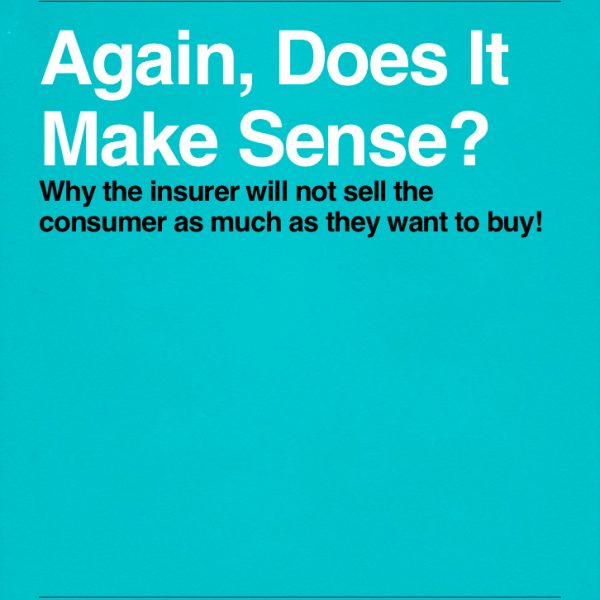The Canadian life insurance industry for decades has been subject to the allure of “shopping” their more difficult risks to various reinsurers to obtain a lower underwriting assessment. “Shopping” is the art of taking all the known information available on a life and sending it to 1,2,3,4, or more reinsurers who say they are experts at finding a more optimistic appraisal of the persons health, occupation, avocation, aviation and/or travel plans. Inevitably insurers have found that one or more reinsurers’ optimism to be strong enough to accept the case without an extra premium or only a trivial extra. As this columnist has stated in previous articles, everybody wins — consumer gets policy at low price, broker gets commission, company gets gross premium, reinsurer gets thin premium, and retrocessionaire gets thinner premium.
A dependence has been cemented binding the insurer to the reinsurers that is unwavering. Every reinsurer supports this marriage and has no inclination to change the status quo. To withdraw competitive facilities of substandard specialists known as reinsurers is almost like withdrawing automatic bank machines. A better analogy is saying that this would be like taking the child who has mastered the two wheeler with training wheels and say you must now go straight to the unicycle!
Legends of reinsurance would cringe at the thought their efforts over decades were about to be erased by those reinsurers experiencing from a tight money policy and/or a misunderstanding of the consequences. After all, facultative underwriting is a labour intensive business requiring skilled personnel (see MO #— “Pusillanimous Underwriters”). A reinsurer could quickly reduce overhead by jettisoning the facultative underwriting service and thus improve the bottom line or reinvest it in more pricing actuaries. Lord knows we could also use more compliance staff to keep up with the sound business practices paper work.
I do not profess to understand what lurks in the minds of some reinsurance management in this insurance business of 1999. Perhaps they have found some revolutionary secret road to success. When I look at the facts of what the sacrifice would be I have to step back and somewhat stoically stand by the insurers who, to the best of my knowledge, want full facultative service from the reinsurers.
How big a market is the substandard, borderline standard and decline group of applicants for insurance? Big enough to sit up and notice the premiums attached are more than enough to fuel the salivary glands of marketing/sales officers. Buried in the CLHIA statistical issues are the numbers that are often overlooked or worse still end up on the wrong desk or filing cabinet. The following chart is a synopsis of the CLHIA report on issued policies.

The number of cases in the survey can be somewhat misleading given the participant companies in the survey can vary and the number of companies is shrinking (merging,, acquisitions, departures, etc.). If we ignore some of the subtle changes and concentrate on the trends I can draw better conclusions. The “face amount” is the amount of risk or coverage in millions (add six zeros or 000,000 for the mathematically challenged).
The numbers when viewed in terms of case count and sums assured over the seven years made me realize I had been preaching an untruth. The fallacy that the business declined and or rated had not changed for years becomes clear. Yes, by number of cases the old adage that about 4% are rated and 3% are declined but look at the other line of numbers. As an industry 6.2% of sum assured is charged an extra premium which is up from 5.1%. In the decline row the increase from 2.6% to 4.9% of business being turned away is quite remarkable. Combining these two categories of risk we are looking at $9.7 billion dollar of sum assured at even $3 per thousand translates to annualized premium of nearly $30 million dollars. The numerical significance is magnified by the perhaps 60,000 policyholders that may feel they were not treated fairly (equitably) by the insurance industry.
If those companies not in the survey magnify the above chart and my numbers the number of disgruntled consumers may be 70,000 and the premium impact rises to $36 million. I am old enough to remember when new premium income of $36 million was significant. I am sure there are many an MGA who would dearly love to control that premium!
For those readers who see the substandard, borderline standard (you know reinsurer likes standard and insurer likes 50 to 100% extra) and decline as “of no significance” can cease reading. For the enlightened few who are still with me, this is a large and potentially controversial group of consumers. To date in Canada we have been free of significant legal battles with individuals who are not acceptable at standard rates. I would like to believe that a relevant factor in avoidance of such a tumultuous path is the predominant use of all availability facilities to keep the price as close to standard as possible if in fact standard is out of the question.
Using a shopped or facultative program where three or four reinsurers try aggressively to outbid (lower price wins) the insurer as well as the other reinsurers keeps the standard group large, the substandard premium minimum and the declines to a minority. No where but in North America do we see such a large number of shopped cases (perhaps close to 200,000 in NA). South Africa is another country with this phenomenon but not having been there to give a speech yet I cannot speak from a first hand basis. We have a free market for sales in insurance and have kept legal encumbrances out of the pricing. In more and more countries companies are forced to accept all risks and only now are some of those countries saying maybe we should avail ourselves of the facultative opportunists.
The seller of our product be it agent or broker has benefited from shopping program. Cases that would disappear into the not taken bucket are in force, commissions paid, company has premium to cover already incurred costs of underwriting and requirements ad reinsurer is tickled pink (Steve is pink politically correct?). Telling the broker their cases will no longer be shopped if they are ratable or decline conjures up visions of veins popping and guns (figuratively only) being drawn. Thirty years of saying “we have sought the best quote from all the reinsurers to get your customer insurance at the lowest price” has warmed the hearts and pocket books of many brokers.
Can you make a lot of money from facultative underwriting. Some skilled reinsurers have specialized in this market for decades and at last glance they are all alive and well with stock values climbing as fast as potentially demutualizing companies only dream. IT is also a fact that most reinsurers started their existence through the facultative channel and grew into rich automatic reinsurers. So when I here through the grapevine that some reinsurers are about to abandon this segment and even throw cold water at it I say to myself “You’re gonna what?”. I cannot believe it is so.
To stretch a premise I see underwriters left without a major tool in their arsenal to get cases issued at low prices. I see brokers and agents left with lost sales and angry consumers who have a fair price one-day and perhaps a decline the next. I see consumer activist groups demanding equally (far different than equitably priced) priced products regardless of medical history. I see a fundamental change in Canada’s life insurance pattern. I also see reinsurers with lower cost, fewer staff and plain vanilla automatic regimes.
I won’t be the first down this new road that is being ploughed through our environment. I can’t condone what I feel is an abandonment of my friends who happen to be my customer. If the industry follows the new road I would have to follow and I would benefit financially from lower costs and fewer staff training and retention issues. I hope to be there to the end helping the last holdout to the shopping program. This is one time I will let someone else lead. And in the end who really cares if their reinsurer decides to get out of facultative underwriting.
I am still left scratching my head asking my peer reinsurers “You’re gonna what?”

